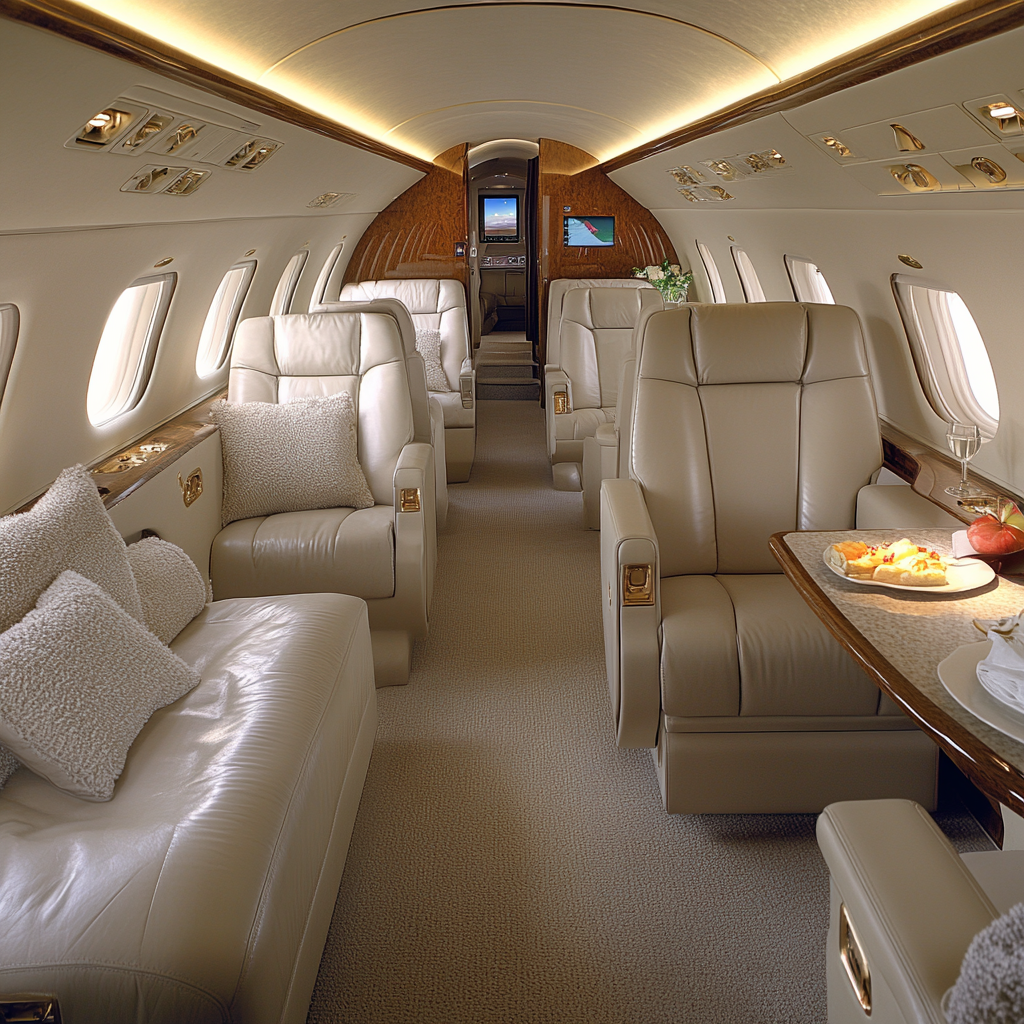In an era where environmental consciousness is at the forefront of global discourse, private jet travel has often been vilified as a symbol of excess and ecological irresponsibility.
The image of a fuel-guzzling luxury aircraft carrying only a handful of passengers seems to epitomize wasteful emissions in a world grappling with climate change. However, a closer examination reveals a more nuanced picture that challenges our preconceptions and invites us to reconsider the role of private aviation in the broader context of sustainable travel.
While it’s undeniable that private jets typically emit more CO2 per passenger than commercial flights, there are scenarios where these luxury aircraft might offer surprising environmental advantages.
This article explores the counterintuitive ways in which private jet travel, when utilized strategically, could potentially yield ecological benefits. By delving into the complexities of aviation logistics, technological advancements, and industry trends, we aim to present a comprehensive view of this controversial topic.
1. More Direct Routes: Cutting Carbon Through Efficiency

One of the most significant advantages of private jet travel is the ability to fly direct routes. Commercial airlines often use hub-and-spoke systems, requiring passengers to take multiple flights to reach their final destination. Each takeoff and landing consumes substantial amounts of fuel, contributing significantly to the overall emissions of a journey.
Dr. Emily Greenwood, an aviation sustainability expert at MIT, explains: “Private jets can often fly point-to-point, eliminating the need for layovers and reducing the overall distance traveled. In some cases, this can result in lower total emissions for a journey compared to a series of commercial flights.”
The efficiency gains from direct routing can be substantial:
- Reduced Flight Time: Direct routes can cut flight times by up to 50% compared to commercial routes with layovers, translating to less time in the air and lower fuel consumption.
- Optimal Altitudes: Private jets can often cruise at more fuel-efficient altitudes, as they’re not constrained by commercial air traffic patterns.
- Weather Avoidance: The flexibility of private jets allows for more efficient routing around adverse weather conditions, potentially saving fuel that would be burned during holding patterns or diversions.
Case Study: A business traveler flying from Seattle to a remote oil field in northern Alberta might need to take three commercial flights, stopping in Vancouver and Edmonton. A private jet could make this trip directly, potentially cutting the total distance flown by 30% and significantly reducing emissions.
To illustrate this further, let’s break down the emissions for this journey:
- Commercial Route:
- Seattle to Vancouver: 127 miles
- Vancouver to Edmonton: 514 miles
- Edmonton to Fort McMurray (nearest major airport to oil fields): 270 miles
- Total: 911 miles
- Private Jet Route:
- Seattle to Fort McMurray (direct): Approximately 750 miles
The direct route saves about 161 miles of flight distance. When you factor in the reduced taxi time, elimination of two takeoff and landing cycles, and the ability to fly at optimal altitudes, the emissions savings become even more significant.
Dr. Greenwood adds, “It’s crucial to note that this efficiency only applies when the private jet is reasonably full. A nearly empty private jet will almost always be less efficient than commercial options.”
2. Flexibility in Airport Choice: Reducing Congestion and Idling

Private jets have access to a much wider network of airports than commercial airlines. This flexibility allows them to land closer to their final destination and avoid congested major hubs. The environmental implications of this capability are far-reaching and often overlooked.
“By utilizing smaller, less busy airports, private jets can reduce time spent idling on runways or circling in holding patterns,” says Air Traffic Controller James Rodriguez. “This not only saves fuel but also reduces the overall environmental impact of a flight.”
The benefits of airport flexibility include:
- Reduced Ground Transportation: Landing closer to the final destination can significantly cut down on ground transportation needs, which often involve less fuel-efficient vehicles.
- Decreased Congestion at Major Hubs: By diverting traffic from overcrowded airports, private jets indirectly contribute to reducing delays and congestion for commercial flights.
- Optimized Infrastructure Usage: Smaller airports often have shorter taxiways and more efficient ground operations, further reducing fuel consumption.
A 2023 study by the International Council on Clean Transportation (ICCT) found that flights arriving at congested airports spend an average of 15-20 minutes in holding patterns or ground delays. For a typical narrow-body airliner, this can burn an extra 200-300 gallons of fuel per flight.
Rodriguez elaborates, “At busy airports like London Heathrow or New York’s JFK, it’s not uncommon for aircraft to spend 30 minutes or more in holding patterns during peak hours. Private jets using alternative airports like London Biggin Hill or Teterboro in New Jersey can avoid these delays entirely.”
Case Study: Consider a trip from Paris to a business meeting in central London:
- Commercial Route:
- Flight to London Heathrow
- 45-minute taxi ride to central London (often in traffic)
- Potential holding pattern and ground delays at Heathrow
- Private Jet Route:
- Flight to London City Airport
- 15-minute taxi ride to central London
- Minimal ground delays due to lower traffic volume
The private jet route not only saves time but potentially reduces the overall carbon footprint when accounting for reduced idling, holding patterns, and ground transportation.
3. Cutting-Edge Technology: Flying the Latest in Fuel Efficiency

The private aviation industry often leads the way in adopting new, more fuel-efficient aircraft models. Many private jet operators pride themselves on maintaining fleets of the latest, most environmentally friendly aircraft available. This commitment to cutting-edge technology can have significant environmental implications.
NetJets, a leading private jet company, recently announced a $10 billion investment in new, fuel-efficient aircraft. “Our newest jets can reduce fuel burn by up to 40% compared to older models,” states NetJets CEO Adam Johnson. “We’re not just talking about marginal improvements; these are substantial leaps in efficiency.”
The technological advancements driving this efficiency include:
- Advanced Aerodynamics: Newer private jets feature optimized wing designs, reducing drag and improving fuel efficiency.
- Lightweight Materials: Extensive use of composites and advanced alloys reduces overall aircraft weight, directly impacting fuel consumption.
- Next-Generation Engines: Modern engines offer significantly better fuel efficiency and reduced emissions.
- Avionics and Flight Management Systems: Advanced navigation and flight planning systems optimize routes and flight profiles for maximum efficiency.
Dr. Robert Chen, an aerospace engineer specializing in sustainable aviation, explains: “The private jet industry’s willingness to invest in the latest technology creates a testing ground for innovations that eventually trickle down to commercial aviation. It’s similar to how Formula 1 racing drives innovation in the automotive industry.”
Some specific examples of these technological advancements include:
- Gulfstream G700: Features Rolls-Royce Pearl 700 engines and an advanced wing design, offering a 12% improvement in fuel efficiency over its predecessor.
- Dassault Falcon 8X: Utilizes an advanced Digital Flight Control System that optimizes the aircraft’s flight profile for maximum efficiency, reducing fuel burn by up to 20% compared to older models.
- Bombardier Global 7500: Incorporates GE Passport engines and a transonic wing design, achieving a 16% reduction in fuel burn compared to previous generation aircraft.
Johnson adds, “We’re also seeing increased interest in electric and hybrid-electric aircraft for short-haul flights. While these technologies are still in their infancy for larger jets, the private aviation sector is poised to be an early adopter, potentially accelerating their development for wider use.”
4. Driving Innovation: The Push for Sustainable Aviation Fuels

The private jet industry is at the forefront of developing and adopting sustainable aviation fuels (SAFs). These fuels, made from renewable sources such as used cooking oil, agricultural waste, or even captured CO2, can reduce carbon emissions by up to 80% compared to traditional jet fuel over their lifecycle.
“The purchasing power and willingness to pay premium prices make private jet operators ideal early adopters for SAFs,” explains Dr. Sarah Chen, a renewable energy researcher. “This demand is crucial for scaling up production and eventually making SAFs more accessible for commercial aviation.”

The impact of the private jet industry on SAF development is multifaceted:
- Creating Demand: Private jet operators are committing to significant SAF purchases, driving production scale-up.
- Investment in Infrastructure: The industry is investing in SAF production facilities and distribution networks.
- Research and Development: Private aviation companies are partnering with fuel producers to test and refine new SAF formulations.
- Regulatory Advocacy: The industry is pushing for policies that support SAF development and adoption.
Recent developments in this area include:
- NetJets’ commitment to purchase 100 million gallons of SAF over the next decade.
- VistaJet’s pledge to be carbon neutral by 2025, largely through the use of SAFs.
- Signature Flight Support’s initiative to make SAF available at all of its private jet terminals globally by 2030.
Dr. Chen notes, “The aviation industry as a whole needs to transition to SAFs to meet climate goals. The private jet sector’s early adoption is creating the market conditions necessary for broader implementation.”
A 2024 report by the International Air Transport Association (IATA) projects that SAF production could reach 30 billion liters annually by 2030, with private aviation accounting for nearly 20% of that demand despite representing a much smaller percentage of total flights.
Case Study: Farnborough Airport in the UK, a major private jet hub, became the first airport in the world to offer SAF for all flights in 2021. This initiative has led to a 50% reduction in the airport’s Scope 3 carbon emissions.
5. Flying at Capacity: Maximizing Efficiency Per Passenger

While it might seem counterintuitive, private jets often fly at or near full capacity. Business groups or families chartering jets typically fill all available seats, maximizing the efficiency per passenger. This utilization rate can sometimes lead to better per-passenger efficiency than partially filled commercial flights, especially on certain routes.
Aviation analyst Mark Thompson notes, “A fully occupied small private jet can sometimes have better per-passenger fuel efficiency than a half-empty commercial airliner, especially on shorter routes.”

To understand this concept better, let’s break it down:
- Load Factors: Commercial airlines typically aim for load factors (percentage of seats filled) around 80-85%. However, this can vary significantly by route and season.
- Private Jet Utilization: Private jets, when used for business or family travel, often operate at 90-100% capacity.
- Aircraft Size: Smaller aircraft, even with higher fuel burn rates, can be more efficient when fully loaded compared to larger, partially filled aircraft.
A comparative example:
- Regional Commercial Flight:
- 50-seat regional jet
- 70% load factor (35 passengers)
- Fuel burn: Approximately 800 gallons for a 500-mile flight
- Per-passenger fuel use: 22.9 gallons
- Private Jet:
- 8-seat light jet
- 100% load factor (8 passengers)
- Fuel burn: Approximately 220 gallons for the same 500-mile flight
- Per-passenger fuel use: 27.5 gallons
While the private jet uses more fuel per passenger in this scenario, the difference is not as dramatic as often assumed, especially when considering the potential for more direct routing and reduced airport congestion.
Thompson adds, “It’s important to note that this efficiency comparison only holds true for fully occupied private jets. The environmental impact increases significantly when these aircraft fly with just one or two passengers.”
6. Easing Commercial Air Traffic: An Indirect Environmental Impact

By ferrying passengers on separate networks, private jets may indirectly contribute to reducing congestion in commercial air traffic. This can lead to fewer delays and less time spent in fuel-burning holding patterns for commercial flights.
A 2023 study by the International Air Transport Association (IATA) suggested that reducing air traffic congestion could cut aviation emissions by up to 5% globally. While private jets are not the sole solution to this issue, they play a role in distributing air traffic more evenly across the aviation network.
Dr. Elena Rodriguez, an air traffic management expert, explains: “Every private jet flight potentially removes several passengers from the commercial system. This can have a cascading effect on reducing congestion, particularly at major hubs.”
The environmental benefits of reduced congestion include:
- Decreased Fuel Burn in Holding Patterns: Aircraft in holding patterns can burn hundreds of gallons of extra fuel.
- More Efficient Takeoffs and Landings: Less congested airports allow for more optimal departure and approach procedures.
- Reduced Ground Delays: Fewer aircraft taxiing and idling on the ground leads to lower emissions.
A real-world example of this effect can be seen in the New York metropolitan area:
- The region has three major commercial airports: JFK, LaGuardia, and Newark.
- Teterboro Airport, primarily serving private jets, handles over 170,000 annual operations.
- If even a small percentage of these private jet passengers were to use commercial flights instead, it would significantly increase congestion at the already strained major airports.
Dr. Rodriguez adds, “While it’s not a complete solution, the private jet network acts as a pressure release valve for the commercial aviation system. This distributed approach to air travel can lead to system-wide efficiencies.”
The Bigger Picture: A Complex Environmental Equation

It’s crucial to acknowledge that, on average, private jets still emit significantly more CO2 per passenger than commercial flights. The potential benefits outlined above are context-specific and don’t negate the overall higher environmental impact of private aviation.
Environmental scientist Dr. Laura Simmons cautions, “While these factors are worth considering, they don’t justify widespread private jet use from an environmental standpoint. The focus should be on making all aviation more sustainable, regardless of whether it’s private or commercial.”
To put this in perspective:
- A typical private jet emits 2-3 tons of CO2 per hour of flight.
- A fully loaded commercial airliner emits about 100 grams of CO2 per passenger per hour.
However, the equation becomes more complex when considering:
- The entire journey, including ground transportation and multiple flight segments for commercial options.
- The purpose and efficiency of the travel (e.g., a CEO visiting multiple sites in a day vs. vacation travel).
- The broader impact on the aviation system and technological development.
Dr. Simmons adds, “We need to look at the entire system. While private jets have a higher per-flight environmental cost, they may enable efficiencies in other areas. The key is to continue pushing for more sustainable technologies across all aviation sectors.”
Recent initiatives in the private aviation sector aimed at improving sustainability include:
- Carbon Offsetting Programs: Many private jet operators now offer comprehensive carbon offsetting programs for their flights.
- Electric Aircraft Development: Companies like Eviation and Pipistrel are developing small electric aircraft suitable for short-haul private flights.
- Hydrogen Fuel Cell Research: Several private aviation companies are investing in hydrogen fuel cell technology as a potential long-term solution for zero-emission flights.
A Nuanced Approach to Luxury Travel
The environmental impact of private jet travel is more complex than it might initially appear. While it’s not a green solution for mass transportation, there are scenarios where it can offer unexpected efficiencies.
As the aviation industry continues to evolve, the lessons learned from private jet operations – direct routing, flexible airport usage, and early adoption of sustainable technologies – may well inform broader improvements in commercial aviation.
The future of sustainable air travel will likely involve innovations from both private and commercial sectors, working in tandem to reduce aviation’s overall carbon footprint. Key areas of focus include:
- Continued development and adoption of Sustainable Aviation Fuels (SAFs)
- Advancement of electric and hydrogen propulsion technologies
- Optimization of air traffic management systems to reduce congestion and improve efficiency
- Implementation of more direct routing options for commercial flights
- Integration of smaller, more efficient aircraft into commercial fleets for certain routes

As consumers and businesses alike grapple with the environmental implications of their travel choices, it’s clear that a nuanced, fact-based approach is necessary. The private jet industry, while often criticized, has the potential to drive innovation and efficiency improvements that could benefit the entire aviation sector.
Dr. Simmons concludes, “The goal should be to make all forms of air travel more sustainable. The private aviation sector, with its resources and flexibility, can play a crucial role in developing and testing new technologies. However, this doesn’t absolve it of responsibility – continuous improvement and a commitment to sustainability must be at the forefront of the industry’s priorities.”
As we move forward, it’s essential to maintain a critical and balanced view of private jet travel. While acknowledging its potential benefits in specific scenarios, we must also continue to push for more sustainable practices across all forms of transportation.
The future of aviation lies not in justifying current practices, but in relentlessly pursuing innovations that will make air travel environmentally viable for generations to come.

